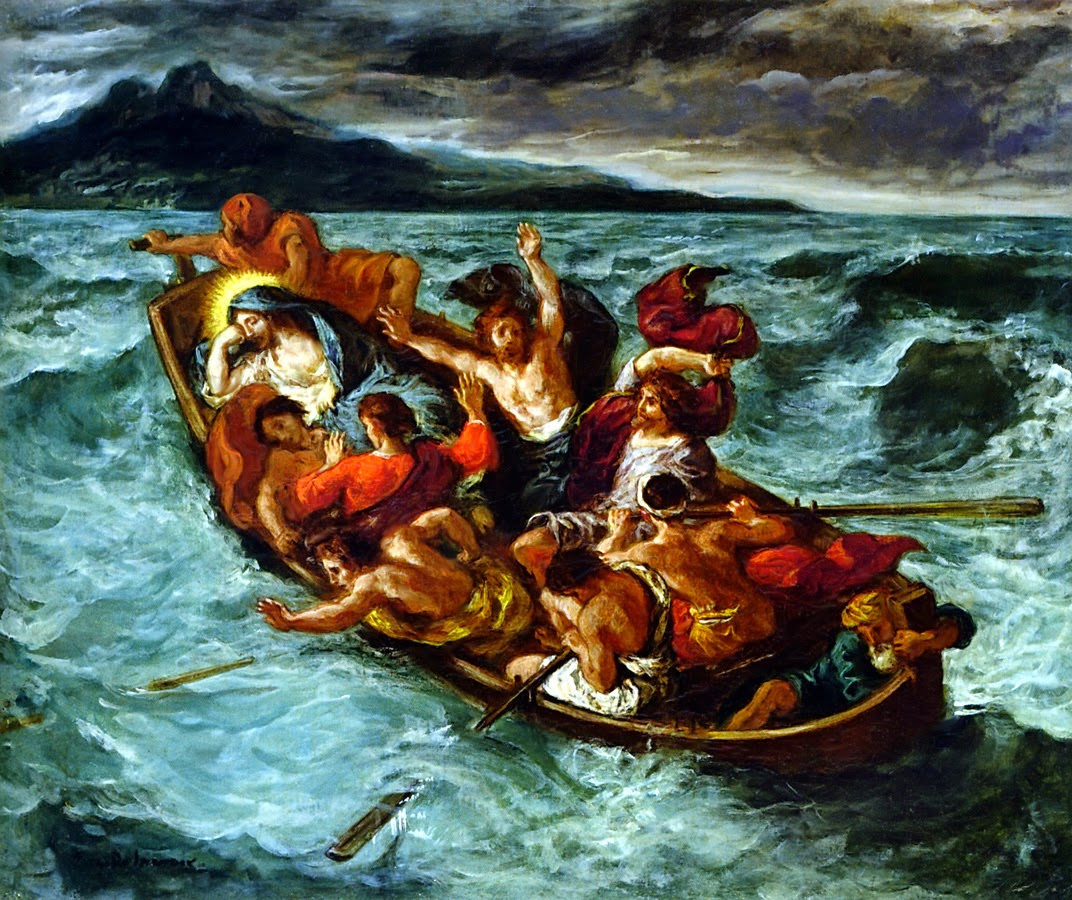Excerpted from The
Miracles of Jesus, 19–22
Mark 4:35–41 gives the earliest account of Jesus stilling
a storm and thereby saving his disciples.
His account is followed with only some modifications by Matthew 8:23–27
and Luke 8:22–25.[3] The first part of the episode sets the scene
by describing the great storm that arose while Jesus and his disciples were on
the Sea of Galilee in a small boat. The
disciples’ terror contrasts with the unperturbed calm of Jesus, who seemingly
would have slept through the storm had his friends had not roused him, begging
for his aid. In the second part of this
miracle story, Jesus, in a moment of divine majesty, “arose, and rebuked (Greek,
epitimēsen) the wind, and said unto
the sea, Peace, be still. And the wind ceased, and there was a great calm” (Mark
4:39). Jesus’ direct rebuke of the storm
is followed by an implicit reprimand of his disciples in the next verse, when
he says, “Why are ye so fearful? how is it that ye have no faith?” The concluding part of the story relates the
reaction of the disciples: “they feared exceedingly, and said one to another,
What manner of man is this, that even the wind and the sea obey him? (Mark 4:41). The common literary motif of greatness weaves
the sections of the miracle story together, stressing the great storm that occasions the miracle, the great calm that ensues, and the great
fear of the disciples that results.[4]
The divinity of Jesus that the miracle at Cana symbolized
was even more clearly demonstrated in those nature miracles that are the
clearest examples of epiphanies, or direct revelations of a divine identity.[1] The twin examples of Jesus’ calming a storm
on the Sea of Galilee and his later walking on that same body of water are
striking illustrations of this because they employ common Near Eastern symbols
of creation, which often involved a deity defeating the unruly powers of chaos,
which were often represented with images of stormy seas.[2] But more importantly, because the Hebrew
Bible credited YHWH, or Jehovah, with the ability to subdue the sea and tread
upon the face of the waters, these New Testament miracles directly connect
Jesus with the Jehovah of the Old Testament.
 |
| First century Galilee boat, Nof Ginosar, Israel |
 |
| Eugene Delacroix, Christ Asleep during the Tempest |
This repeated emphasis on greatness underscores Jesus’
connection with the Old Testament YHWH who could cause the flood to recede
(Genesis 8:1), divide the Red Sea (Exodus 14:21; Psalm 106:7–11; Isaiah 51:10),
and cause storms to arise and to subside (Jonah 1:4, 15–16; Psalm 89:8–10;
93:3–4; 107:25–30). But while God could
be the force behind tempests to accomplish his purposes, some storms result
from independently acting forces of nature, which since the fall can be
unpredictable, dangerous, and even contrary to his purposes. As a result, the Lord at times must rebuke
the waters (Psalm 104:7), even as Jesus rebuked the wind on the Sea of Galilee
(Mark 4:39). This adds an important
element to the image of Jesus as Jehovah: whereas he had originally brought
order out of chaos as Creator, since the fall his creation has become prone to
disorder, making it necessary for him to “reorganize” it. This idea of re-creation is, in fact, a type
of Jesus’ role as the one who would reverse the effects of the fall, giving us
hope that sickness, disability, age, war, other conflicts, and even the death
that characterizes mortality will one day be overcome and set right.[5]
But beyond being an epiphany that reveals the divine
identity of Jesus as Creator and Re-creator, the mighty act of calming the
storm can also be characterized as a rescue miracle.[6] Indeed, in Matthew’s version, the disciples
cry out, “save (Greek, sōson) us: we perish” (Matthew 8:25,
emphasis added). Just as the sailors on
the ship to Tarshish had to rouse a sleeping Jonah to pray for the Lord to end
the storm that threatened them, so Jesus slumbered during the Galilee storm,
untroubled, and apparently not in any danger, from such a temporal tempest.[7] But where Jonah prayed to the Lord, asking
him to calm the tempest, Jesus himself rebukes the storm and brings peace. The original audience of Mark is generally
understood to have consisted of a small, persecuted Christian community in and
around Rome,[8]
which would have compared their own trials and struggles to being caught in a
dangerous storm. They, like the original
disciples on the boat with Jesus, may have had a crisis of faith as they waited
for the Lord to rescue them but would have taken heart that he would, in fact,
save them in time.[9] This is where readers and believers today can
find modern application: just as YHWH could rescue his people from actual
storms on the sea and bring them safely to their port (see again Psalm
107:23–30), when storms of life arise for us, Jesus will save us if we have
faith and will call upon him. Beyond
that, the use of the word “save” (Greek, sōzō)
also connects Jesus’ miracle here to the deeper, spiritual salvation that comes
through the atonement.[10]
[1]Theissen, The Miracle Stories of the Early Christian
Tradition, 94–99.
[2]Achtemeier, “Person and
Deed: Jesus and the Storm-Tossed Sea,” 170–75; Harrington, The Gospel of Matthew, 123.
[3]Twelftree, Jesus the Miracle Worker, 113–14,
155–56.
[4]Meier, A Marginal Jew, 2.925–28.
[5]Achtemeier, “Person and
Deed: Jesus and the Storm-Tossed Sea,” 176.
[6]Theissen, The Miracle Stories of the Early Christian
Tradition, 99–101.
[7]Meier, A Marginal Jew, 2.931–32; Twelftree, Jesus the Miracle Worker, 70–71.
[8]Witherington, The Gospel of Mark, 31, 34–36.
[9]Marcus, Mark 1–8, 336–37.
[10]Twelftree, Jesus the Miracle Worker, 112–13.
No comments:
Post a Comment